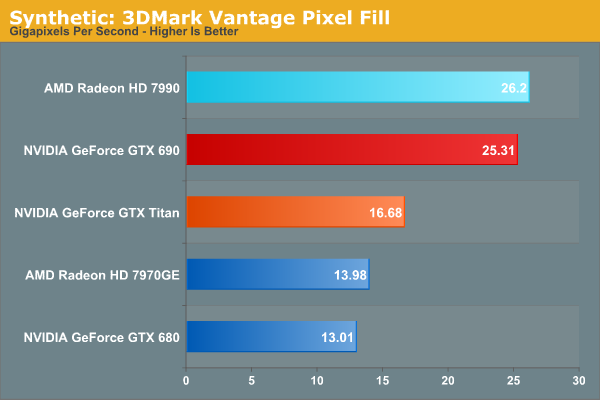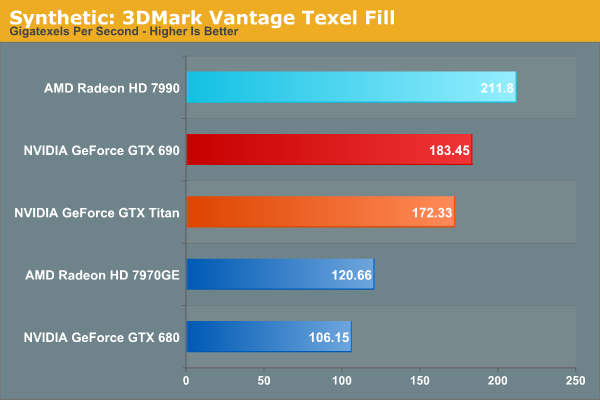AMD Radeon HD 7990 Review: 7990 Gets Official
by Ryan Smith on April 24, 2013 12:01 AM EST- Posted in
- GPUs
- AMD
- Radeon
- Radeon HD 7000
- Tahiti
Synthetics
As always we’ll also take a quick look at synthetic performance, though as a multi-GPU card using a known GPU, there shouldn't be any surprises here. These tests are mostly for comparing cards from within a manufacturer, as opposed to directly comparing AMD and NVIDIA cards. We’ll start with 3DMark Vantage’s Pixel Fill test.

There’s not much to say here. So long as the 7990 isn’t throttling, its ROP/memory performance is almost twice that of the 7970GE, reflecting the fact that the two cards’ clockspeeds are so close.
Moving on, we have our 3DMark Vantage texture fillrate test, which does for texels and texture mapping units what the previous test does for ROPs.

Texture fillrates are the same story as pixel fillrates: the 7990 is an extremely capable card.
Finally we’ll take a quick look at tessellation performance with TessMark.

And again, we're seeing almost perfect scaling from the 7970GE to the 7990 in our synthetic tests.










91 Comments
View All Comments
Plattypus - Wednesday, April 24, 2013 - link
There's a typo on the Specification Comparison chart, you put 7970 instead of 7990 for the first one.Great review!
deestinct - Thursday, April 25, 2013 - link
There is no typo. It IS 7970 CF. CF stands for CrossFire, which means two 7970s. Therefore the comparison makes sensedeestinct - Thursday, April 25, 2013 - link
Ah sorry ignore my previous comment....i misunderstood what you saidjust4U - Wednesday, April 24, 2013 - link
One thing that bother's me about this and Nvidia's offering. You sort of "hope" (expect.. would be better..) that these types of cards would bring something more to the table besides just a dual stack of their top end card. Higher clocks, better memory.. something.jeffkibuule - Wednesday, April 24, 2013 - link
Power savings compared to 2 cards in SLI/CrossFire. Ability to fit in a smaller chassis. Use of the best binned chips possible. But yeah, it really is for the 1%.mr_tawan - Wednesday, April 24, 2013 - link
Single card also means no need for SLI/Cross Fire mainboard (which save money a bit).Rookierookie - Wednesday, April 24, 2013 - link
I don't know if you are spending $999 on your graphics card that saving money is really an issue. You are not likely to be using a low-end motherboard, and many of the high end motherboards support SLI/Crossfire anyway.just4U - Wednesday, April 24, 2013 - link
The power draw appears to be (in my opinion) partially due to the lower speeds. The cards are for a select crowd but I don't see the draw. There should bring something new to the table which would help to entice buyers.Ktracho - Wednesday, April 24, 2013 - link
There is a fair amount of variability in power consumption from one chip to another. Always choosing two chips that are on the low power side makes a significant difference compared to two chips chosen at random, because in the latter case, the design has to account for the worst case - two chips that are on the high power side.stren - Wednesday, April 24, 2013 - link
5 real monitor outputs and SFF is what it's about for those with unlimited cash, otherwise you'd be better off with mulitple lightnings or matrix cards. Until they support 2D lightboost then I'll be sticking with Nvidia.